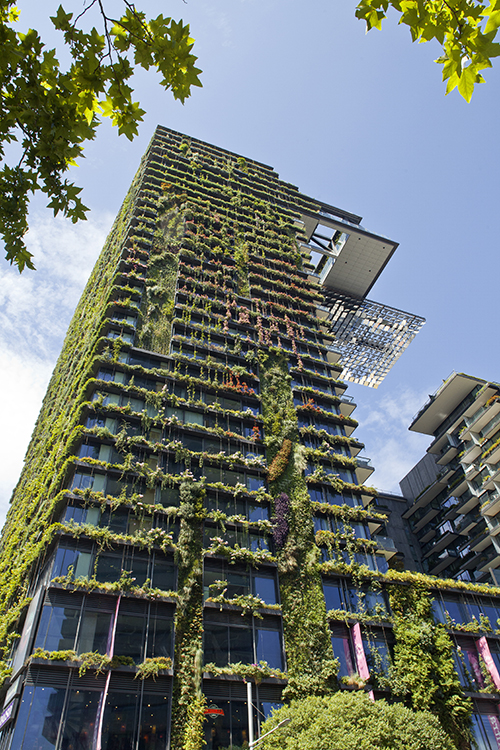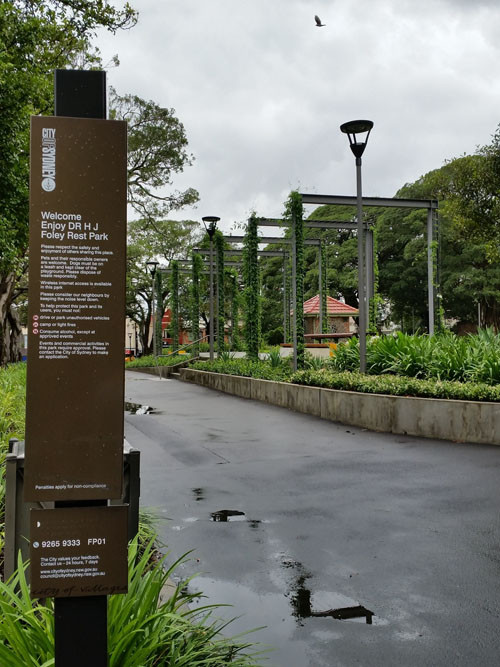Vertical gardening systems can offer numerous benefits – from increased privacy, cooling and shade to the ability to create lush gardens even within very small spaces.
Vertical gardens are growing in popularity for larger installations, such as in public spaces, and on residential apartment blocks and commercial properties. Popular types include green walls, green facades, and freestanding vertical garden systems.
1. Green walls
Green walls (or “living walls”) are comprised of containerised plants or modular green panels positioned across a wall face. Suitable green wall plantings might include herbaceous and shrub-like species or even small trees.
There are various types of green wall systems available. For example, in a substrate-based system, growing medium for the plants is packed into containers, and drip trays can be used to collect water run-off. In hydroponic systems, the plants are attached to an inert medium such as a felt mat or horticultural foam which holds moisture for the plants to draw on.
Green walls can be outdoor or indoor, although each will have different requirements in terms of light, plant species and other factors.
Tower Four at Collins Square in Melbourne is an example of a successful indoor green wall. With over 13,000 plants stretching 52.9m high this is the tallest installation of its kind in Australia. Created by Fytogreen, the wall provides numerous benefits for the building. This includes passive cooling and absorption of indoor pollutants and carbon dioxide – which in turn creates cleaner and healthier air for the building’s occupants.
2. Green facades
Green facades differ from green walls in that they are made up of climbing or scrambling plants that grow upwards or across a support structure such as a trellis.
In a green facade, plants may be grown hydroponically or in a growing medium. Typical green facade plants include twiners like honeysuckle, tendrils such as clematis, and scrambling plants such as winter jasmine.
As for green walls, there are different types of facades. Ground-based facades are composed of plants grown in soil at ground level with a trellis to attach to. In a facade-bound system, plants are grown at different levels above the ground – such as in planter boxes that contain the growing medium.
Stainless-steel support structures are particularly suited to green facades, as they are durable and robust. Steel support structures for facades include single wire ropes for twiners and low scramblers, cross-hatch systems to suit leaf-stem climbers, or pre-formed mesh for climbers, scramblers and planter boxes.
To be successful, support structures need to be professionally engineered and correctly tensioned for the plants at installation and maturity, as well as other loads on the system.
An excellent example of a commercial green facade is the 34-storey installation at One Central Park in Sydney. The three facades of this installation comprise thousands of hydroponically-fed climbers and vines supported by 15kms of stainless steel cables, providing cascades of greenery that appear to spill out down the building.

3. Freestanding vertical gardening systems
Freestanding vertical gardens are appearing in parks, gardens and other spaces across the world. These systems consist of plants grown upwards and sometimes overhead on vertical garden frames. This type of vertical garden system can provide a pergola-like experience for users.
Foley Rest Park in Sydney is a typical example. It consists of over 400m of stainless-steel cable that supports various climbing plants, creating a beautiful arbor for the public to use.
For further advice on vertical gardening systems involving the use of engineered stainless-steel cabling, mesh or vertical garden frames, get in touch with us.







































